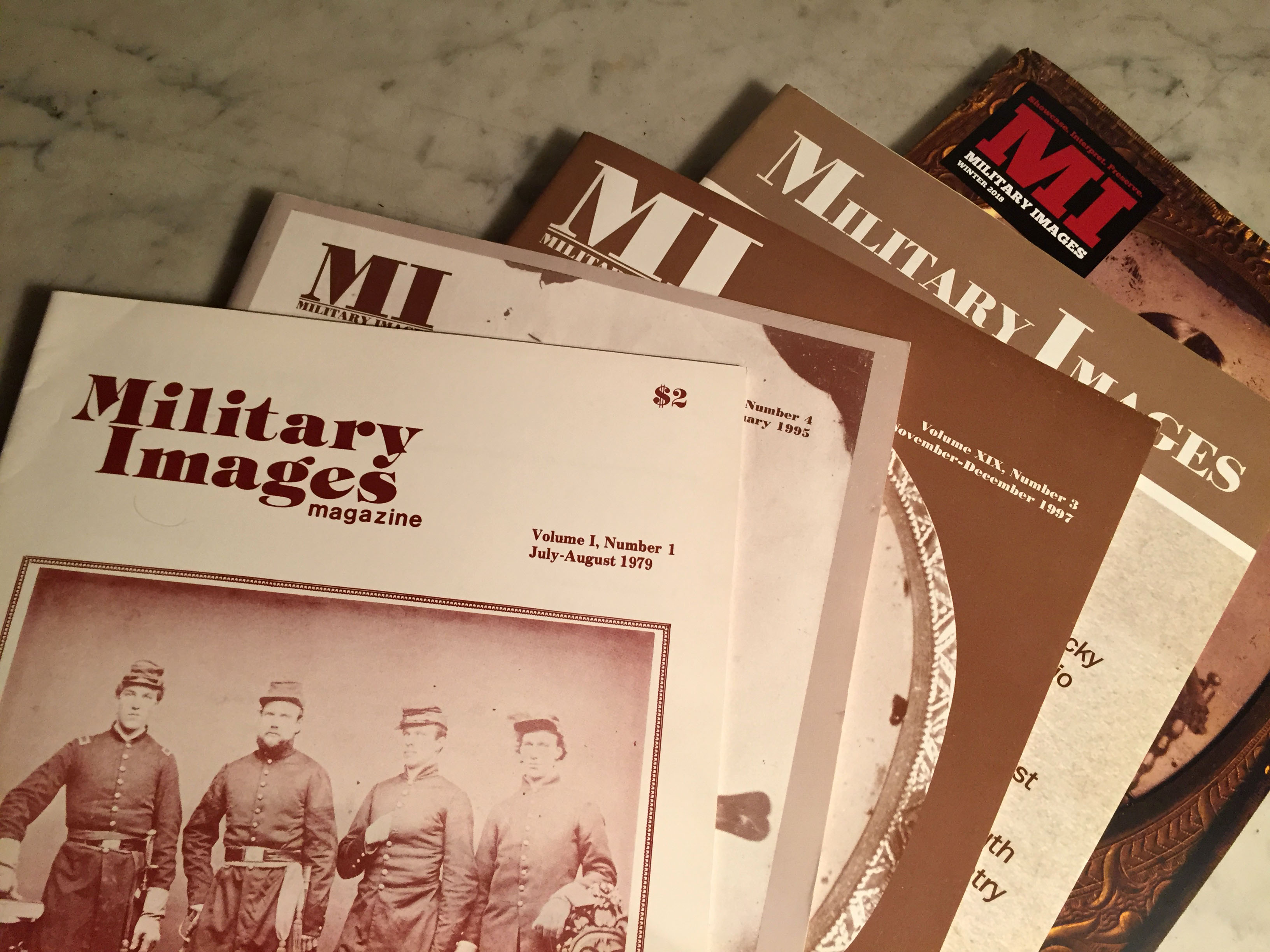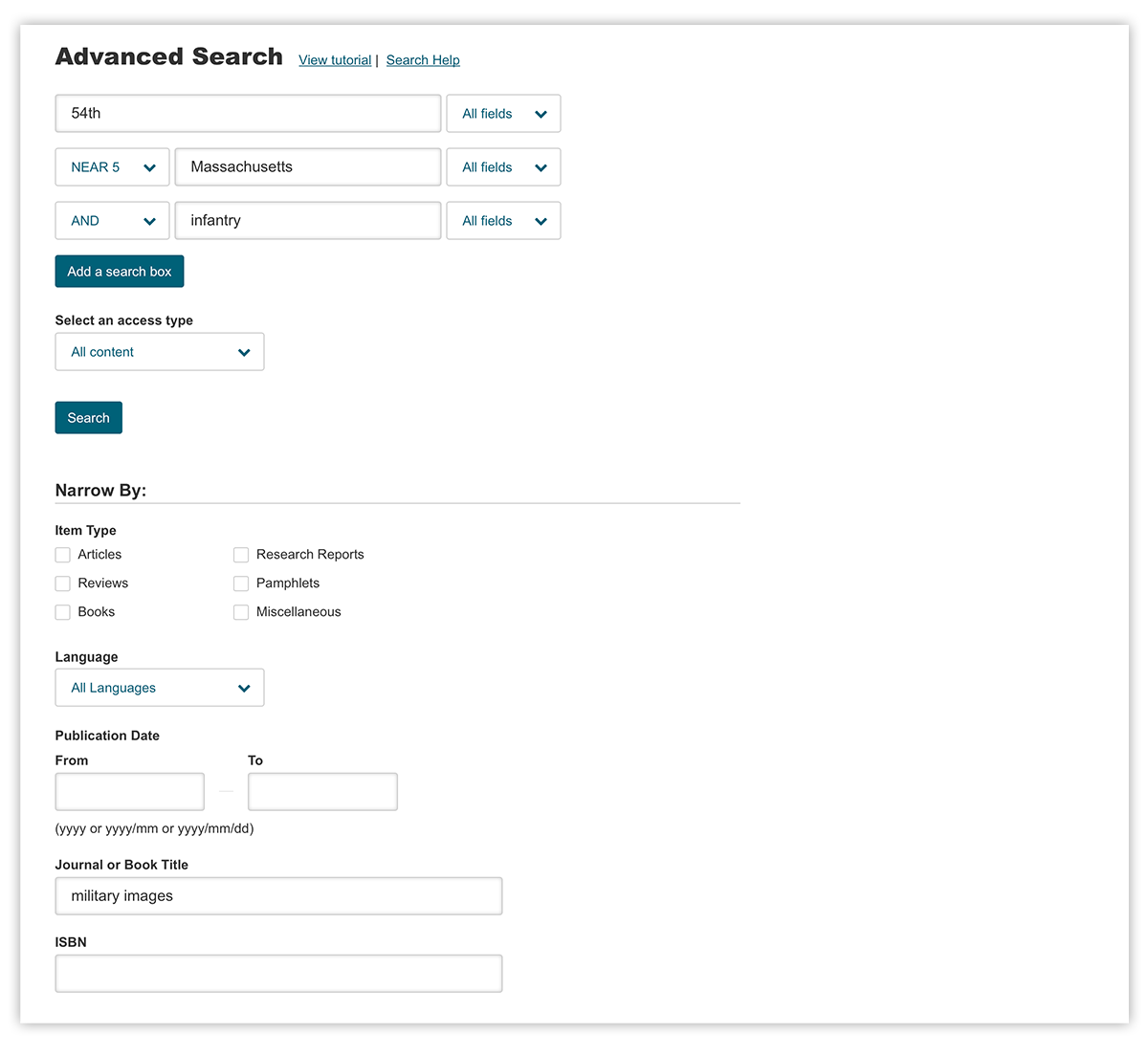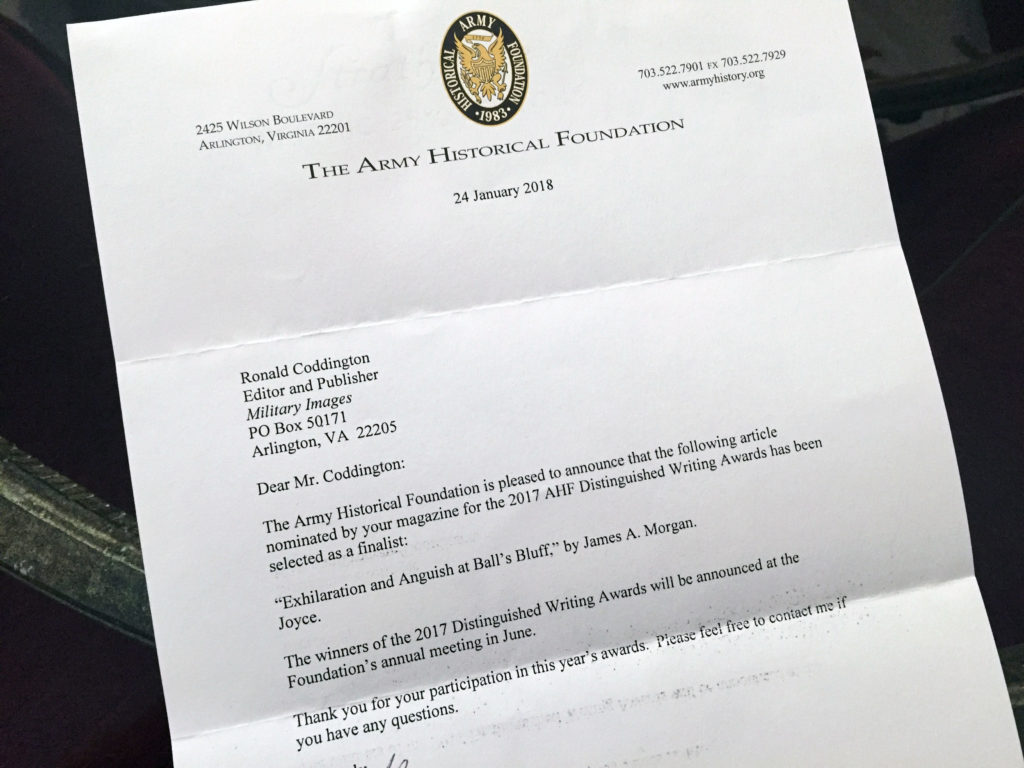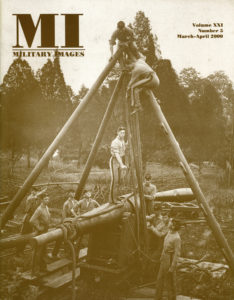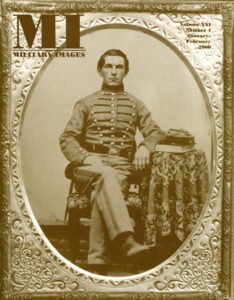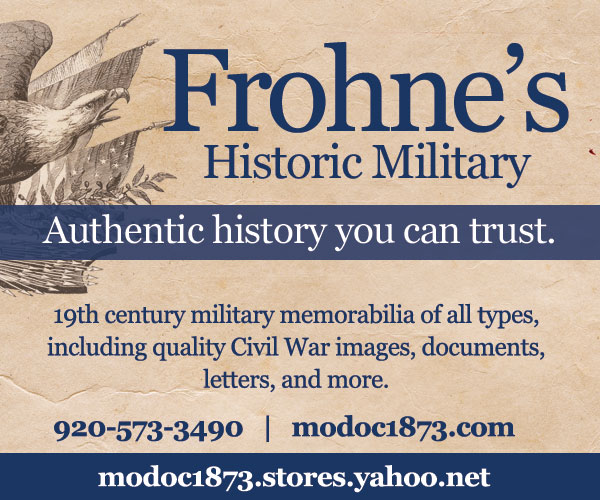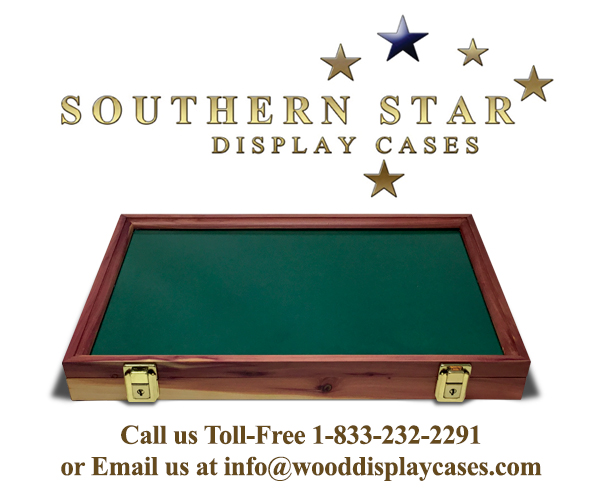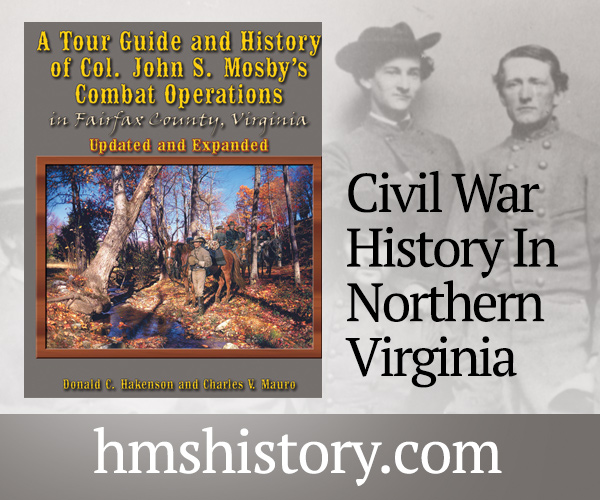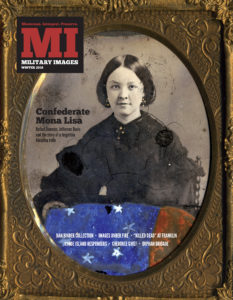 The complete issue
The complete issue
Vol. XXXVI, No. 1
(80 pages)
Print edition: Visit our store to check availability
Digital edition: Visit JSTOR.org to purchase
Subscribe to MI ($24.95)
Explore the MI Archives: Browse | Advanced search | Tutorial
Inside
Cover image
A quarter-plate ambrotype from the Doug York Collection pictures Virginia Ware with the Confederate First National flag.
Download (free)
Table of Contents (p. 1)
Download (free)
Editor’s Desk (p. 2)
In “Our Initiative to Educate Future Historians,” the editor announces the results of the Young Historians campaign and introduces the idea of sponsoring subscriptions.
Download (free)
Mail Call (pp. 3-4)
Feedback includes praise for the last issue, a cover story party for the Rich Jahn family, the emergence of a Civil War image of Walter H. Thomas, Enfields and Springfields, and more.
Download (free)
Passing in Review (p. 6)
Ron Field’s Silent Witness: The Civil War Through Photography and Its Photographers (Osprey Publishing) captures the spirit of the men behind the camera.
Download (free)
Antebellum Warriors (p. 8)
A sixth-plate ambrotype by Mathew B. Brady from the National Portrait Gallery Collection pictures George Henry Thomas about 1855, when he was an army major. Thomas would go on to serve as a Union major general during the Civil War and earn the nom de guerre “Rock of Chickamauga.” This image is part of a current National Portrait Gallery exhibit.
Most Hallowed Ground (p. 10)
Rose Adéle Cutts, the crème de la crème of Washington society, married Sen. Stephen A. Douglas. After his untimely death in 1861, she went into an extended period of mourning. Her home, the Douglas Mansion, became a hospital for Union soldiers. She lived in an adjacent villa and visited soldiers regularly. After the war, she married an army officer, Robert Williams.
Photo Sleuth by Kurt Luther (pp. 12-14)
Kurt observes, “Facial recognition is a key consideration in photo sleuthing. Rarely definitive, face recognition is fundamentally hard, for both humans and computers.”
Confederate Mona Lisa by Doug York with Ronald S. Coddington (pp. 16-18)
Surviving documents and photographs tell the story of a forgotten Alabama belle, Virginia Frances Ware, and her connections to a prominent Vicksburg, Miss., family, famed Alabama raider Raphael Semmes, and a young naval officer connected to the highest levels of the Confederate government.
Red Blankets & Blue Blouses: Faces of Rhode Island’s First Responders, April-June 1861 (pp. 19-30)
A survey of 18 portraits of Rhode Islanders who were prompted to enlist after the bombardment of Fort Sumter. They became the 1st Rhode Island Infantry. Identified individuals include Ambrose E. Burnside, Augustus Woodbury, William L. Bowers, Moses Brown Jenkins, William Chace, Addison Hyde White, Joseph Pope Balch, Lewis Richmond, Joseph Story Pitman, William S. Smith, Jesse Comstock, James Henry Chappell, George Frank Low and Peter Simpson Jr.
Crystal Clear: Representative portraits from the Dan Binder Collection (pp. 31-41)
A longtime collector of non-dug, pre-1865 Civil War buttons, Dan Binder changed his focus to photography in 2010. Since then, he’s amassed more than 400 images, of which 27 examples are included here.
Uniforms & History by Michael J. McAfee (p. 44)
In “Military Schoolboys Fostered ‘Virtuous Citizens,’” McAfee discusses the importance of military schools in American society, and notes that President Donald J. Trump attended one. Two cartes de visite of cadets illustrate the text.
Carried into Battle: Images that came under fire—and survived (pp. 45-53)
A rare grouping of images found on battlefields includes an ambrotype taken from the body of a dead Confederate at Port Hudson, La., a carte de visite of a Union soldier found by “W.A.S.” at The Wilderness, a tintype of a federal corporal discovered at Shiloh, an ambrotype of a civilian picked up by a noncommissioned officer at Shiloh, a carte de visite of a sister carried by her brother at Irish Bend, La., and a group of five cartes de visite pierced by a bullet at Petersburg.
At Franklin, “Killed Dead:” Life and loss of a Georgia lieutenant by Willis Treadwell with Ronald S. Coddington (pp. 54-57)
Among the men who perished in the crushing Confederate defeat at the Battle of Franklin was a Georgia husband and father of four, George Washington Whitecotton. He is buried in the McGavock Cemetery. His portrait and a photo of the watch returned to his family illustrates the text.
The Virtuous Knight of the Orphan Brigade: Kentucky’s Lafayette Hewitt by Brian Boeve with Rusty Hicks (pp. 58-61)
Known as Fayette to his family and comrades, Hewitt started the Civil War as an employee in the fledgling Confederate postal service. He left to join the army and served at first in a staff position. He eventually realized his goal of serving as a combat officer—and he became a distinguished fighter. His legacy includes important primary source records that detail the history of his beloved Orphan Brigade. His portrait illustrates the text.
Here Among the Chiefs: The Cherokee Nation’s Lewis Downing, in gray and blue by Scott Vezeau with Ronald S. Coddington (pp. 62-65)
The Civil War divided the Cherokee Nation as much as it did the North and South. One of the men who ultimately sided with the Union, Lewis Downing, started his military career as a Confederate chaplain. After President Abraham Lincoln issued the Emancipation Proclamation, he had a change of heart—and uniform. A rare portrait of the man who would someday lead his people is inscribed on the back in Cherokee.
A Few Minutes and a Street Block: A Massachusetts soldier recalls his wounding at Fredericksburg by Scott Valentine (pp. 67-69)
Josiah Fitch Murphey, a sergeant in the 20th Massachusetts Infantry, was struck in the face by a bullet during the early stages of the Battle of Fredericksburg. “Drenched in blood and feeling faint, he stumbled down Hawke Street and back across the river to a field hospital quartered at the Lacy House,” notes the author. Murphey survived his wound, but the pain stayed with him for a lifetime. His portrait illustrates the text.
Rare profile portrait of the Confederacy’s First General by John O’Brien (pp. 70-71)
A rare image of Gen. Samuel Cooper, and three other portraits of the first soldier to be appointed general in the regular army of the Confederacy, includes a biographical sketch. The second and third generals were Robert E. Lee and Joseph E. Johnston.
The Boat that Brought Stonewall Home: A unique panoramic view evokes the life and death of Gen. Thomas J. Jackson by Warren “H” Shindle (pp. 72-73)
Two images, one well known and another never before published, form a panorama of a section of the James River & Kanawha Canal. Floating on the waterway is the packet boat Marshall, which carried Stonewall Jackson’s remains to its final resting place. Among the landmarks in the background is the ruins of Virginia Military Institute, where Jackson served as an instructor.
The Origin of Military Images by Harry Roach (p. 74)
The founding editor and publisher of MI recounts how he started the magazine, and how he came to be inspired by photo historian William Frassanito. The essay is part of Pioneers, an occasional series that documents Civil War photograph collectors and how they got started.
Stragglers: Distinctive Images from MI contributors (p. 75)
Four images are included, and each portrait features a man with the Stars and Stripes.
The Honored Few: Medal of Honor Recipients (p. 76)
In “’Red Burial Blent’ at Nashville, the actions of Col. Philip Sidney Post are detailed. “He was calm, imperturbable, absolutely unaffected by the surroundings, simply going right at the great object that was in front of him.” That object was the Confederate army. Post received the Medal of Honor for his actions.
Sutler’s Row (p. 79)
The Last Shot (p. 80)
A quarter-plate tintype from the Rick Brown Collection is a portrait of a Southern trooper who may hail from Mississippi.
